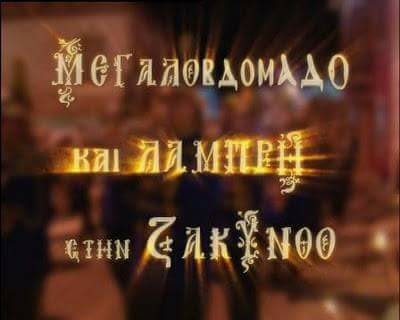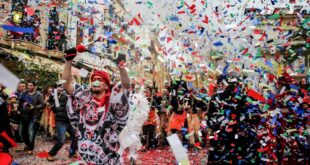Holy Tuesday
7.30 pm, the Holy Metropolitan Church will perform the Bridegroom.
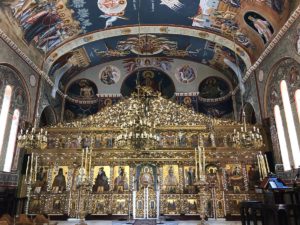
The name of the service is from the figure of the Bridegroom in the parable of the Ten Virgins found in Matthew 25:1-13.
The churches of Faneromeni, Zakynthos town and in the Village of Ambelokipi will sing the Hymn of Kassiani, also known as the hymn of the Fallen Woman, highlighting the story of The Hymn of Kassiani, that is based on the Gospel reading for Holy Wednesday morning, which speaks of a sinful woman who anoints Jesus’ feet with costly ointment. This hymn is chanted only once a year and is considered a musical high-point of the holy Week.
On Holy Tuesday the Church calls to remembrance two parables, which are related to the Second Coming. The one is the parable of the Ten Virgins, the other, the parable of the Talents. These parables point to the inevitability of the “Parousia” or Judgement Day, to be prepared for the Day of Judgment. According to the Gospel of Matthew, the five virgins who are prepared for the bridegroom’s arrival are rewarded, while the five who are not prepared are disowned.
Whilst the other, The Parable of the Talents according to the Gospel of Matthew tells the story of a master who entrusts his property to his three servants and in accordance to the abilities of each man, each servant received a talent. One of the three servants received five talents, the second servant received two talents, and the third servant received one talent. The servants were sent out to make use of their talents and when they returned home the master asked his three servants for an accounting of the talents he entrusted to them.
The first and the second servants explained that they each put their talents to work and doubled the value of the property with which they were entrusted and each servant was rewarded by the master. However, the third servant had not utilized his gift and merely hid his talent, so he was punished by his master and deal with such subjects as spiritual vigilance, stewardship, accountability and judgment.
HOLY WEDNESDAY
16.00 pm, the Mystery, Blessing at the General Hospital”s church of Zakynthos
18.30 pm the Holy Eucharist will be performed in the Holy Temple of St. Dionysios.
Holy Wednesday the middle of Holy Week, the themes over the next few days are emphasised intensely.
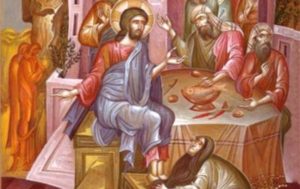
Holy Wednesday is about the plot to kill Jesus and also repent for our sins.
On the Wednesday before his death, Jesus was in Bethany, in the house of Simon the Leper. As they sat at the supper table, a woman named Mary anointed Jesus’ head and feet with costly oil of spikenard. The disciples were indignant, asking why the oil was not instead sold and the money given to the poor.
However, Judas Iscariot wanted to keep the money for himself. Then Judas went to the Sanhedrin and offered to deliver Jesus to them in exchange for money. From this moment on, Judas sought an opportunity to betray Jesus. The start of Judas’ betrayal and the repent of a woman that sort help in Christ.
Churches all over Zakynthos, begin a service of Anointing (Holy Unction) it is held, usually in the afternoon depending on the church . This is in commemoration of the anointing of Jesus, and a preparation of the faithful for those who wish to receive Holy Communion on Great and Holy Thursday. The faithful will take with them cotton wool to dip in the blessed oil and it is then used to anoint those within the family who could not make it to the service.
Tradition also has it, in some areas; women take a large bowl of flour to the Holy Unction and place candles in it, which burn during the ceremony. The next day, the flour is used to make Easter biscuits known as koulourakia.
During the service you will be anointed by the priest, symbolizing with a cross on each cheek, forehead, chin, palms of your hand and then at the back of your hand. This is done after the reading of seven Epistle lessons known as the ‘Ιερό Ευχέλαιο, seven Gospel lessons and the offering of seven prayers, which are all devoted to healing, it is then the priest anoints the body with the Holy Oil. The anointing oil is considered to be very therapeutic. After the service many faithful will have taken the soaked piece of cotton wool which had been dipped in the Holy oil to take home and give to those who were unable to be at the service to make the cross signs, particularly on their hands and face
HOLY THURSDAY
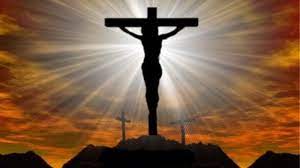
08.00 am the Divine Liturgy of the Great Kingdom will take place at the Holy Metropolitan Church of St. Nicholas.
08.30a.m Divine Liturgy, most village churches. St. Nicholas Ambelokipi
19.00p.m St. Nicholaos church of Ambelokipi, and most village churches will read the 12 gospels.
19.30p.m the Holy Dormition of Saint Parish (Holy Passion) will be carried out at the Church of St. Dionysios, Zakynthos Town,
Holy Thursday is a special day for Zakynthians. Most will go early for Holy Communion, it is the day that most will have taken their communion and to break their 40 days of Great Lent. However, Zakynthians still keep strict lent even for those who have not fasted up until now they have already started During Holy Week up until Holy Saturday after midnight mass when for the first time meat, eggs and dairy products will be laid on the Easter table.
Holy Thursday evening, all the churches are open for the readings of ‘The Great Supper’ and the lead up to the biggest event in which Zakynthos is claimed to hold the most spiritual event throughout Greece. The church bells will not chime on Holy Thursday evening until Holy Saturday evening after midnight mass; this is in respect to Christ being nailed on the cross. Most churches will also decorate the Epitaph with flowers, a notable difference is the Metropolitan Church in which its epitaph is a masterpiece in woodwork, therefore the epitaph is not decorated with flowers.
After midnight Zakynthos is in mourning, for it is Friday that Christ was crucified and ‘penthos’ is carried out, not only in the churches but in every Zakynthian household.
Around Zakynthos you will probably notice black flags known as (τα μαύρα πεύκια) hanging from the balconies or hung in windows during the litany the flags will be flying at half mast as well, right up until dawn of the first resurrection which is on Holy Saturday morning.
Red Thursday as some may call it as it is when most after Holy Communion will dye their eggs red. However, the true Zakynthian will wait till the first resurrection on Holy Saturday morning after the Gloria to dye their eggs.
As well as eggs and according to tradition, housewives prepare the ‘tsourekia’ or Easter bun and Easter biscuits will be made from the flour that had been blessed on Holy Wednesday.
The egg symbolizes fertility and creation while according to others they symbolize the rebirth of the world and the renewal of nature.
The red colour symbolizes the blood shed by Christ when He was crucified.
The eggs are dyed as a symbolic reason as to where Jesus gave bread and wine as symbolic of His body and blood, ready to be sacrificed to free the world from the bondage of sin.
The story of The Virgin Mary as well, has been told that she took a basket of eggs and offered them to the guards, imploring them to treat her son well, as her tears fell upon the eggs they turned red.
Mary Magdalene even took her eggs that had turned red to the Roman emperor informing him of the Resurrection of Christ, as he considered it as improbable as “eggs being dyed red.”
Another story goes that there was talk among the people and one woman did not believe the news of the resurrection of Christ and was heard saying
“When the eggs I am holding turn red, then Christ has risen.” Of course they turned red.
After the twelve gospels throughout the churches of Zakynthos, the preparation on the tomb will take place. In the village of Ambelokipi it is a ritual that has been done for many years. The women stay and place flowers on the tomb encasement that will carry Christ during the service of Holy Friday evening.
It is here that you will hear a lament called ‘Moiroloi” which is a song that is sung for the deceased and only sung by women.
HOLY FRIDAY
08.00 a.m St. Dionysios church (Holy Servi
10.15 a.m the Evening Sequence (Disappearance).
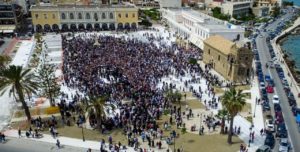
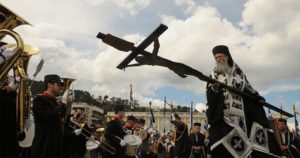
14.00p.m St. Nicholas of Molos (Solomou Square), the official Litany of the Crucified, according to the Zakynthian tradition. Many cultural and religious associations take part in the litany, a must see for those who have visted us, especially for our Easter religious Events.
19.30p.m St. Dionysios church, the Holy Dormition of the Holy Saturday (Holy Sepulcher). At the church of Saint Nicholas, in the village of Ambelokipi the traditional Hymns will be sung by the only women’s choir in Zakynthos, where they will also sing the lament of Christ, an old tradition that has recently be revived. A litany of the Christ in his tomb will be taking place.
AFTER MIDNIGHT
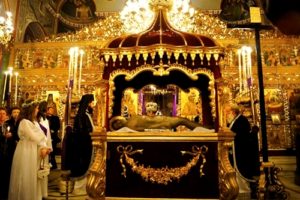
(HOLY SATURDAY)
02.00a.m am the Holy Metropolitan Church of St. Nicholas, the Holy service starts for the Epitaph. The town comes alive, and many wait in anticipation for the litany of the Epitaph.
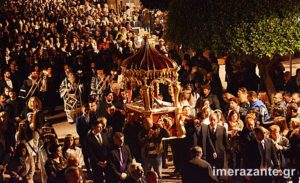
04.30a.m the official Epitaph, Litany through Zakynthos Town. As soon as the Epitaph returns to the church, around 05.30a.m the first Resurrection (Gloria) and the Divine Liturgy. This is where people will gather to break their clay pots, which takes place under the clock in Saint Marcos square.
Holy Friday in Greece is one of the most Holiest days of the year known as Megali Paraskevi.
Zakynthos has its own unique way of celebrating this day, if you haven’t already noticed the church bells haven’t been ringing over the last few days, today however the bells, especially in the village areas, will be in strict traditional ‘Penthos’ mourning sound. Throughout the town you may see traditional black flags called ‘Pefki’ hanging from the balconies and windows.
Traditions have it that even today the usual everyday chores are stopped, at the dinner table no one is seated and no tablecloth is placed. At noon the litany of the ‘Stavromeno’ where at the end of the litany the Archbishop of Zakynthos will bless the four corners of the earth, this is done outside the church located in Solomos square.
However, the highlight is in the evening, during the ‘Epitaph’ especially in the village of Ambelokipi, where it is not so common to hear women’s choir, as usually the choirs comprise of only men. The ‘Egomia’ will be sung but in the village of Ambelokipi an extra traditional song called ‘miroloi’ is included in their service, im which I mentioned above. A ‘moiroloi’ which is a tradition from ancient times where songs would be made up talking about the person’s pain and suffering, in this case it is a song about Christ being crucified, and the pain suffered by our Virgin Mother.
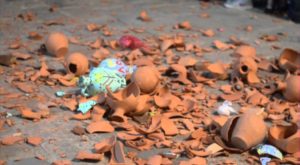
Another highlight, would definitely be the Epitaph and parade that takes place in Zakynthos town, this is done in the wee hours of Saturday Morning. The church service usually starts around 02.00a.m and then around 04.30a.m Epitaph is taken around the town, once it returns the ‘Gloria’ takes place, known as the first resurrection. It is here with the first light of Saturday Morning, usually just before 06.00a.m, that Zakynthians will have gathered under the clock in St. Marcos square to break their clay pots.
This is a ritual in its own right. Before the calling that ‘Christ has resurrected’ people gather, coins are thrown on the ground to resemble the 30 pieces of silver that Judas got paid for delivering Jesus and the breaking of the clay pots to resemble the door of His tomb being broken, the first sign of His resurrection. Meanwhile, at the same time in the church the feeling of an earthquake will be felt as church lights are flashing and the huge chandeliers swing, the faithful join in on the confusion, waiting for the Archbishop to call out ‘Christ Has Risen’. It is difficult to decide which is more memorable, however the first time I encountered the event in the church, I was totally impressed, I must admit I have not seen anything like it. After the service the faithful return home in the first light and will then usually break a pomegranate as a symbol of rebirth.
Holy Saturday Evening
23.00 pm, Churches around Zakynthos will carry out the Orthodox Sequence,
23.45p.m. In Saint Marcos square, Zakynthos town, the Sacred Procession will take place from the Metropolitan church for the Resurrection Service in St. Marcos Square.
After the Resurrection service churches will continue their readings for Easter Sunday (midnight mass).
Holy Saturday and most Zakynthians would have returned from Zakynthos town early hours in the morning, after the first ressurection.Today is the highlight of Holy Week, it is when Zakynthians will take the Holy light from the church and bring it within their homes.
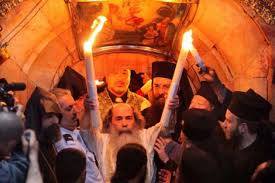
The Holy light has made its way from the Holy lands direct from Jerusalem and then is sent to every corner of Greece in time for the Holy celebrations.
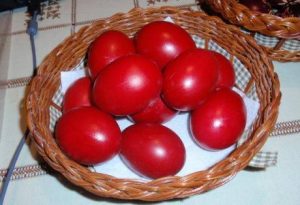
Preparations start early for the ‘Anastasi.’ Most would have dyed their eggs red for this evening’s ‘tsougrisma’. As soon as the Holy light reaches the homes, a symbol of a cross is marked across the threshold to bring health and prosperity into the home. The family will then prepare for the feast but not before they start the (τσούγκρισμα), with the Easter eggs. The red eggs symbolize the resurrection of Christ and the competition of who has the best egg that doesn’t break under the pressure of them being hit at each end by your opponent starts off the celebrations.
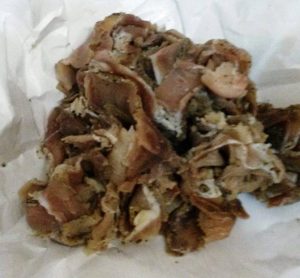
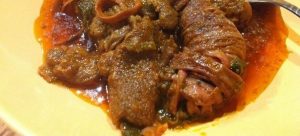
The feast is the breaking point of the Great Lent, and the dish that most serve within Zakynthian homes is a dish known as sgatzeto (Σγατζέττο) either with an egg and lemon sauce or as most prefer tomato based sauce. Served along with the dish is of course ‘ladotiri’ (local cheese) and ‘Hiromeri’ (gammon).
Celebrations will start at around 11.30p.m when all will be ready to go to church to hear the ‘Gloria’. The priest usually starts the service outside among the people, most will have their candles with them, especially children in which their godmothers and godfathers have chosen for them. It is an important day and an honour to take back the Holy light, without being blown out along the way. As the clock strikes twelve midnight the church bells will chime in harmony for the first time after ‘penthos’ (mourning). Greetings of ‘Xristos Anesti’ (Christ has risen) and ‘Alithos o Kirios’ (the Lord is true) will be heard amongst the people. Fireworks will be let off in the night sky and children will let off firecrackers whenever they can. As all leave the church voices can be heard, laughter and Kalo Paska (Καλό Πάσχα) wishes for a Happy Easter as they set off for home with joy and the Holy light to bring within their homes. Before they enter their home they will make a sign of the Cross over their doorway as a symbol of good luck. Then all will sit to eat for the first time after Great Lent a meat dish or soup called ‘Skatzeto’.

A significant (τσούγκρισμα) is played or ‘who’s got the best and strongest egg. A game that Greeks don’t take lightly. The aim is to choose a red-dyed egg of your choice and then try to knock your opponents out by breaking their egg. Bottoms first, then tops or whichever way you choose. Whoever wins is said to be blessed.
Easter Sunday
10.30a.m until 13.00p.m the Eminent Metropolitan, after blessing the Easter Eggs, will receive greetings at Archontariki of the Holy Monastery of St. Dionysios
19.30p.m at the Holy Trinity Church, St. Lazarus City, The litany of the Sacred icon of the Resurrection and the Most Holy Theotokos of Galanousa.
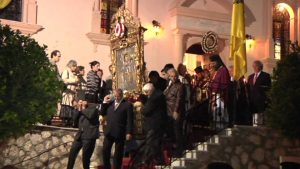
Easter Sunday, was a tradition in Zakynthos to eat ‘egg and lemon soup’ but once again this tradition is slowly dying out as the influence of mainland Greece has made its way into most Zakynthian homes. Due to the perfect weather conditions as well, BBQing lamb or goat on the spit, will be the dish of the day, slowly roasting over hot flames in the backyard. Sounds of gunshots will be heard throughout the villages when the lamb is cooked and taken from the spit ready to eat.
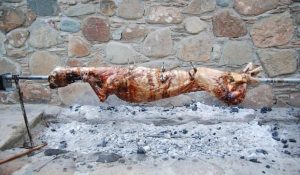
EASTER MONDAY
20.00P.M at the Holy Trinity Church of St.Nikolaos Kalamos to the Church of the Holy Trinity, the litany of the Sacred icon of the Resurrection and the Virgin Mary of Laurentina.
 Zakynthos Informer Zakynthos Informer
Zakynthos Informer Zakynthos Informer

